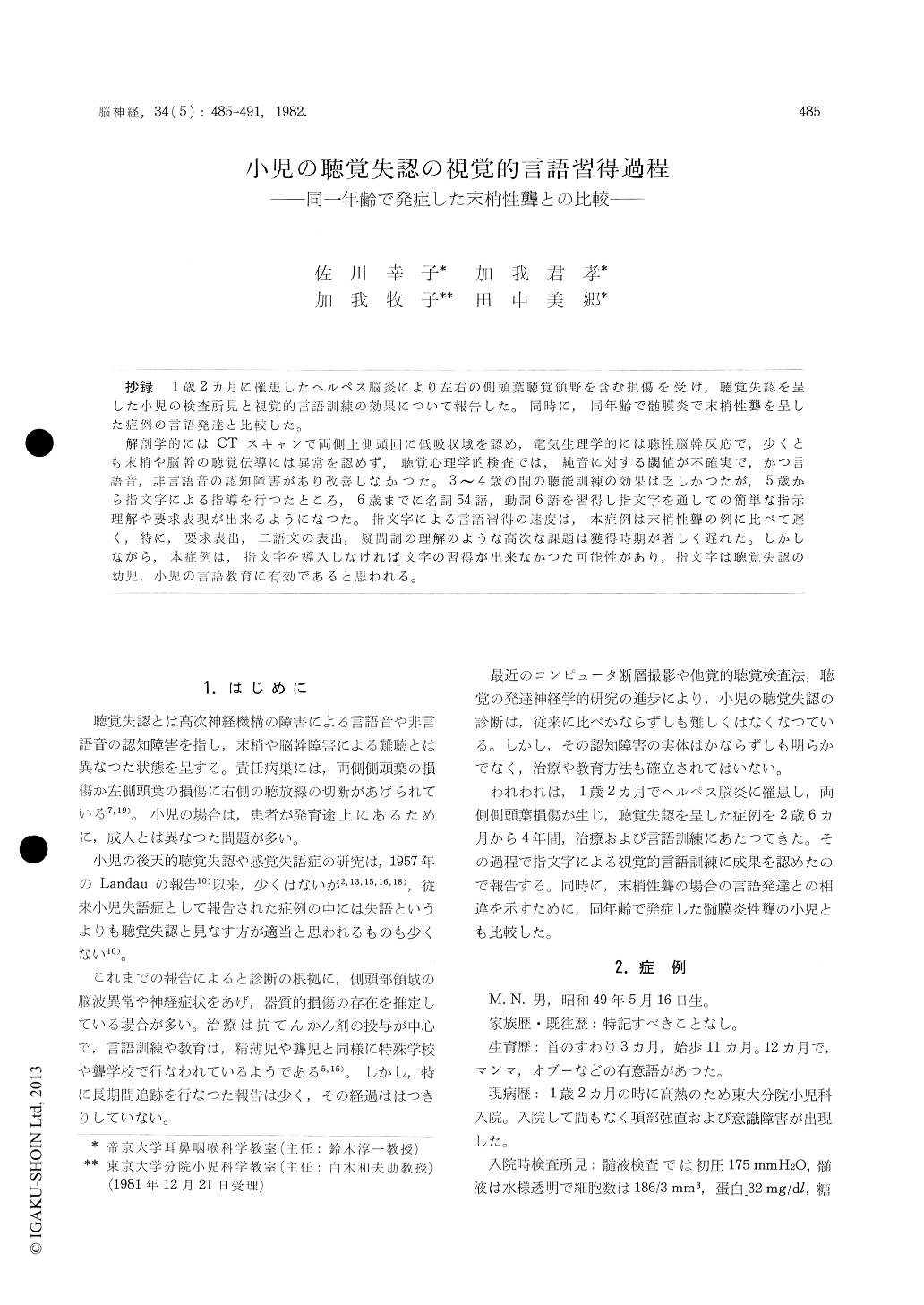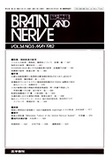Japanese
English
- 有料閲覧
- Abstract 文献概要
- 1ページ目 Look Inside
抄録 1歳2ヵ月に罹患したヘルペス脳炎により左右の側頭葉聴覚領野を含む損傷を受け,聴覚失認を呈した小児の検査所見と視覚的言語訓練の効果について報告した。同時に,同年齢で髄膜炎で末梢性聾を呈した症例の言語発達と比較した。
解剖学的にはCTスキャンで両側上側頭回に低吸収域を認め,電気生理学的には聴性脳幹反応で,少くとも末梢や脳幹の聴覚伝導には異常を認めず,聴覚心理学的検査では,純音に対する閾値が不確実で,かつ言語音,非言語音の認知障害があり改善しなかつた。3〜4歳の間の聴能訓練の効果は乏しかつたが,5歳から指文字による指導を行つたところ,6歳までに名詞54語,動詞6語を習得し指文字を通しての簡単な指示理解や要求表現が出来るようになつた。指文字による言語習得の速度は,本症例は末梢性聾の例に比べて遅く,特に,要求表出,二語文の表出,疑問詞の理解のような高次な課題は獲得時期が著しく遅れた。しかしながら,本症例は,指文字を導入しなければ文字の習得が出来なかつた可能性があり,指文字は聴覚失認の幼児,小児の言語教育に有効であると思われる。
A child with auditory agnosia for verbal and nonverbal sounds was reported. He was born with-out difficulty and his early development was normal. At the age of 14 months, he suffered from herpes simplex encephalitis and fell in a trance. Soon after he recoverd from the illness, he found not to pay any attention to sounds and not to speak any words.
He was reffered to Teikyo University hospital at 2. 5 years of age for the hearing measurement. The average threshold of conditioned orientation reflex audiometry at 500, 1000 and 2000 Hz were 85 dB, while the threshold of auditory brain stem response was 15 dB which is normal. CT scan demonstrated bilateral lesions of superior temporal gyrus. Neurological examination revealed nothing particular except the troubles with hearing and speech. He was made a diagnosis of auditory agnosia.
The speech therapy was started at two years old. During the first three years, he was taught how to communicate with gestures and lip reading. How-ever, it was difficult for him to understand the meaning of gestures and lip reading. During these years he could acquire lip reading of simple words. As to environmental sounds, he could respond the tele-phone-bell and the organ at three years and seven months old. but could not discriminate other sounds.
At five years old, finger spelling for his language education was introduced. He appeared to have learned finger spelling more easily and could read and write several letters through finger spelling within a month. One year after introduction of finger spelling, he acquired about 60 words (54 nouns and 6 verbs) and could read words and two-words sentences. However, the speed of his aquisition of language was very slow for his age. Now, he can understand mother's simple instructions and communicate with his mother and his speech therapist through finger spelling, but his responses toward environmental sounds are not stable yet. The course of this patient suggests that language acquisition of children with auditory agnosia might be different from that of deaf children.
The prognosis of auditory agnosia in children is controverscial. In this patient, the development of language is not good as well as in most previous reports, perhaps because of extensive lesions of language area.
The patients with auditory agnosia is frequently mistaken for deaf or mentally retarded children. We emphasize that the early diagnosis and early speech therapy with visual communication are needed for these children.

Copyright © 1982, Igaku-Shoin Ltd. All rights reserved.


